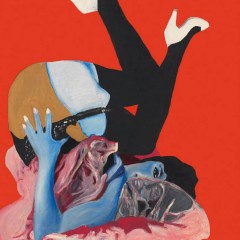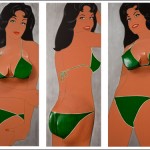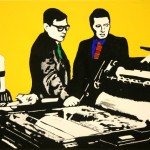Painter of pop noir, Rosalyn Drexler, whose collage paintings from the 1960s blew us away when they appeared at Rosenwald-Wolf Gallery in 2004, is having a solo show at Pace Wildenstein Gallery! This is excellent news for all who are interested in correcting art history’s record and including strong artists like Drexler who were overlooked the first time around.
I interviewed Drexler in 2004 (read the Q&A) and found her to be a warm, smart, nicely-quirky and delightful person. The Pace show, in the gallery’s 545 W. 22nd St. space, is called I am the Beautiful Stranger: Paintings of the 60’s and it runs March 16, 2007 — April 21, 2007.
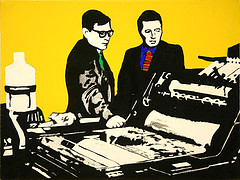
Rosalyn Drexler, Study for Men Machines, 1965. from the 2006 show Rosalyn Drexler and the ends of man at Paul Robeson Gallery, Rutgers, Newark, work from 1961 — 2001.
I reviewed the R-W show for the Weekly but never put the copy in the blog so I’m putting it below for some context and to whet your appetite. Here’s the link to the PW art page. I’ve got more pix at flickr.
Resurrection Muse
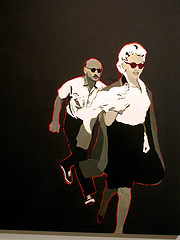
Rosalyn Drexler, Marilyn Pursued by Death, 1967
With spare graphic imagery showcased against backgrounds of flat, saturated color, Rosalyn Drexler’s collage paintings at Rosenwald-Wolf Gallery throw themselves at you with vigor and a kind of dry-ice sizzle.
If I didn’t know better I’d say these works were made yesterday.
But Drexler’s show “To Smithereens” is not a debut exhibit. It’s a retrospective of works from 1961 to 2003 by a woman who’s a contemporary of pop artists Alex Katz, Andy Warhol and George Segal.
Many of the biggest, boldest works date from the 1960s–and that makes this show shocking. The work is amazing, prescient, accomplished and memorable.
I spoke with the artist by phone recently and asked about paintings like Marilyn Pursued by Death (1967), an image that’s as good an icon of the movie star as you’ll find anywhere. Drexler–who’s also written several novels and won four Obies and an Emmy Award (for a Lily Tomlin special)–explained that when her gallery, Reuben Gallery, closed after only one or two seasons around 1960, the other artists got picked up by other galleries. But she didn’t.
“Women were not bankable at that time … I received no offers,” she says. Being married with a young child may also have worked against her.
“A lot of the men were very political and were aware of how to promote themselves. I, on the other hand … had no clue as to a career. What can I say? It’s different now, thank God. Women know how to promote themselves.”
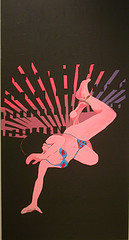
Image of Ana Mendieta falling
It’s possible that Drexler’s edgy work with its emphasis on death (a boxer killed in a prize fight; Ana Mendieta falling to her death; a group of white men accused of a race murder) was a hard sell. Most pop was cool (think Katz or Lichtenstein). Even Warhol had lighter works that made it into the mainstream (soup cans, Brillo boxes). His death-soaked electric chair and car crash scenes are far less known and exhibited.
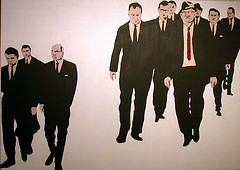
Southern men accused of a race murder.
But Drexler is a groundbreaking artist. Her technique alone qualifies her for the history books. She was the first to embed images based on newspaper photographs in her canvases.
“Nobody else was doing this,” she says. “Tom Hess, a critic at the time … wrote I was the first person to use photos–to cut them and put them on canvas.”
She was also the first to paint sequential images from television, as she did in her six-screen sequence Death of Benny “Kid” Paret (1963).
Asked about her technique, she says, “I was hiding the image and giving it another face, like bringing the dead back to life in a strange way. I was very guilty about it–achieving something not out of your head. Little did I know [this technique] would become so hot.”
In his essay in the show’s brochure, Robert Storr compares Drexler to artist Raymond Pettibon‘s “brooding, maverick sensibilities.” Like Pettibon’s, Drexler’s works convey angst about the world that’s as relevant today as it was 40 years ago.
Drexler is in collections at the Whitney and the Hirshhorn museums, but I had never heard of her. It’s thanks to curator Sid Sachs (Rosenwald-Wolf Gallery)that this important and reverberant work has been brought to light.


